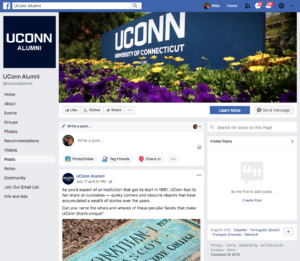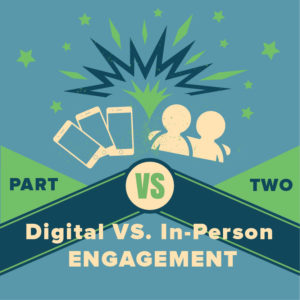Digital engagement in higher education advancement is vastly under-resourced in comparison to traditional engagement, particularly around alumni events and programming.
A sustained digital alumni engagement strategy can make an immense impact in activating new and previously engaged alumni to participate in a variety of roles, including volunteer, donor, ambassador, mentor, and listener. Its potential seemingly has such a higher ceiling than in-person engagement that it’s preposterous for teams to not invest in digital engagement at the same level as traditional engagement.
But can this be proven? Can this disproportion be quantified? Or can this potential be calculated? We’ll dig into these questions and more as this series continues.
(Click here to read part one: Making the Case for Digital Engagement)
Into the Great Wide Open
Many alumni offices are quite active across the big social media channels, sharing stories about alumni achievements, university news, campus life, school nostalgia, student success, contests, and more with audiences of thousands.
Alumni are engaging with these posts 24/7: reading, clicking, liking, commenting, sharing. These small — but very real — interactions become more than just moments. They’re part of a collective experience, even part of a social media ritual for some. Yes, a repeated connection on a regular basis with their alma mater and with fellow alumni.
These are powerful stories that build relationships, and these stories are delivered by small, under-resourced teams.

Don’t Come Around Here No More
Now look at alumni events and programming. The volume of time, planning, people, and money that goes into a single marquee event such as a reunion, alumni day, or homecoming is often monstrous. Even singularly focused, seemingly simple events like lectures, speed networking, happy hours, mixers, and more require a healthy amount of coordination and resources to pull off.
Even if a new event attendance record is set for a single in-person event, that record will likely equate to a fraction of a percentage of the total alumni population. Though, for those who do attend, that single event can leave a lasting impression. If the event is exciting or inspiring enough, that may become part of a collective experience of repeat attendance over a long period of time. Then again, if the event is boring, uninspiring, or worse, that may also have a powerful impact on subsequent attendance decisions.
On digital, a bad experience is more likely to be forgotten or redeemed on account of post frequency and variety. With events, it’s one shot… wait a while… try again… keep your fingers crossed.
And yes, delivered through often exhaustive and well-resourced efforts.
Between Two Worlds
 Curiously, today’s alumni events and programs simply could not exist without digital engagement or technology.
Curiously, today’s alumni events and programs simply could not exist without digital engagement or technology.
Imagine running events today with no email marketing, no event registration, no event websites, no event apps, hashtags, or social media promotion.
It’s unthinkable.
Even if alumni registered for such an event by way of print invitation and phoned-in RSVP with a non-compliant credit card transcription, there would be no automated way to connect their event attendance data to the greater alumni database.
But these events do exist through digital engagement and they generate sasquatch-sized footprints of digital data for alumni offices.
Not only do these events exist thanks to digital, much of this hefty portion of event information management and marketing is done by those small digital communications and technology teams.
A Higher Place
It’s imperative that we embrace digital alumni engagement, whether it’s to create new channels of alumni connection to accommodate modern expectations, enhance traditional and in-person engagement, or gather a bounty of digital data.
Some institutions understand the value of digital engagement and are shifting strategies, resources, and staff accordingly (here’s an example… and another). Others continue to lean heavily on traditional, costly engagement methods without allotting for a more expansive exploration of digital. Schools that disregard this turning point in the evolution of alumni engagement do so at their own peril.
By virtue of digital’s successful penetration in other industries as well as in higher ed, it’s easy to find examples that can serve as selling points for those in advancement bravely attempting to make a case for resources and strategy around digital engagement.
But how should institutions quantify the success of digital alumni engagement and compare such efforts with those made for in-person engagement?
We’ll explore these questions as this series continues.
Jon Horowitz’s 14 years of experience at the intersection of higher ed communications, technology, and engagement propelled him into his current role as an independent strategic consultant for higher education institutions. Prior to becoming a consultant, Jon drove digital engagement strategy at Princeton University and Rutgers University. Follow Jon on Twitter @hrwtz and check out horowitzstrategy.com for more on Jon and his work.